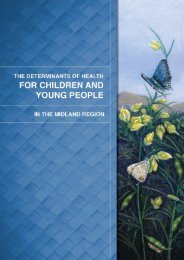Project SPLICE - Taranaki District Health Board
Project SPLICE - Taranaki District Health Board
Project SPLICE - Taranaki District Health Board
Create successful ePaper yourself
Turn your PDF publications into a flip-book with our unique Google optimized e-Paper software.
<strong>Project</strong> <strong>SPLICE</strong> FINAL - February 2010<br />
Drawing on the models of international best practice outlined above, the key elements of<br />
the services proposed for the <strong>Taranaki</strong> DHB region are:<br />
a. Comprehensive assessment;<br />
b. Enhanced care management functionality;<br />
c. Active client management and individualised lifestyle and support planning;<br />
d. Integration across health and social care; and<br />
e. Clinical leadership and workforce development.<br />
The proposed model has three distinct aspects, Care Clusters of health professional teams<br />
aligned to General Practice that are locally based, a <strong>District</strong> Support and Development Unit<br />
and consolidation of triage and coordination functions.<br />
3.2 Assessment systems<br />
Assessment for people with long term conditions who are not older tends to specific to the<br />
disease state in questions. For instance, a 45 year old man with Heart Failure may be<br />
assessed using a tool such as the Self Care of Heart Failure Index, where as older people, due<br />
to the increase in co-morbidities with age and increase in frailty require a more<br />
comprehensive assessment approach. Comprehensive health assessment covers several<br />
domains of health and welfare including: physical, psychological, social, community support<br />
and functional status and is beneficial for older people as their problems span broad areas of<br />
need [32-35]. Assessment leads to recommendations for interventions appropriate to the<br />
older person’s needs. To be effective, assessment must be followed by implementation of<br />
recommendations [36]. Comprehensive assessment and management have been proven for<br />
older people [37, 38].<br />
Specific to older people is the development of interRAI, a United States based not-for-profit<br />
organisation with membership from notable international gerontologists and clinicians. The<br />
organisation has developed and implemented a range of assessment tools specific to older<br />
people. Following a systematic review of the literature on comprehensive geriatric<br />
assessment instruments [39] and trial implementation and evaluation across six DHBs [40],<br />
two tools (MDS-HC or Minimum Data Set Home Care and Contact assessment) are being<br />
supported by the Ministry of <strong>Health</strong> for national implementation. Carpenter [41-43] reports<br />
that the tools have significant benefits in that:<br />
a. They facilitate the consistent and comprehensive assessment of older people;<br />
b. The use of the tools support assessors to consider the whole person;<br />
c. Care is based on accurate, reliable information;<br />
d. The results of the assessment assist clinicians in identifying problems and potential<br />
for improvement; and<br />
e. Inter-disciplinary staff involvement in assessment and care planning is improved.<br />
Further, the data arising from the assessment facilitates the monitoring of indicators of<br />
quality of care, which in turn allows for evaluation of impact on case mix and resource<br />
management as well as clinical effectiveness.<br />
20 | P a g e

















